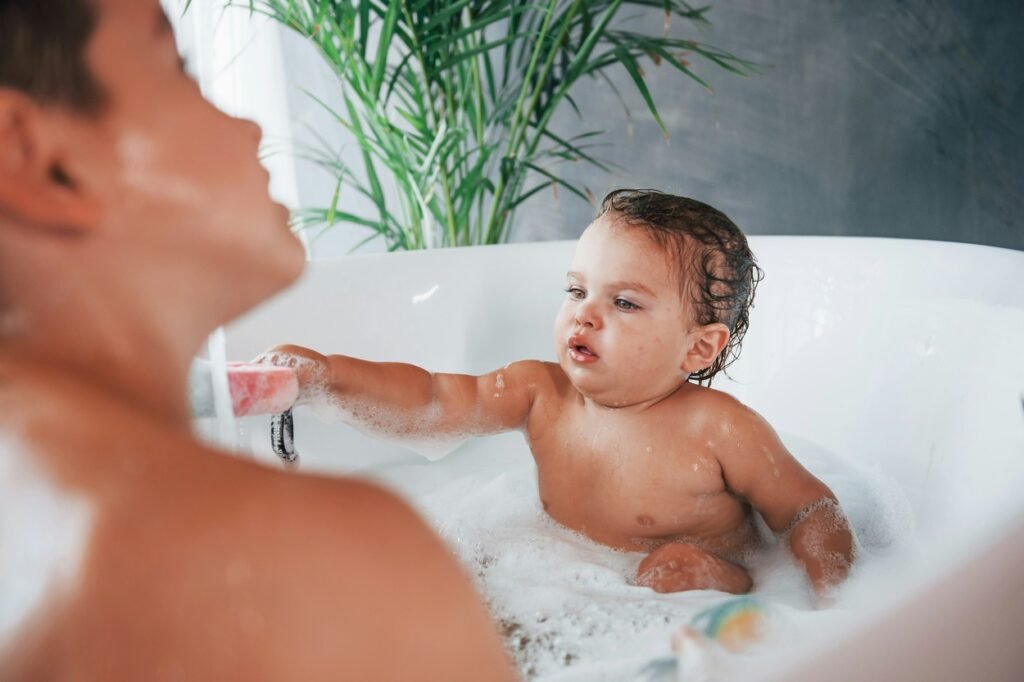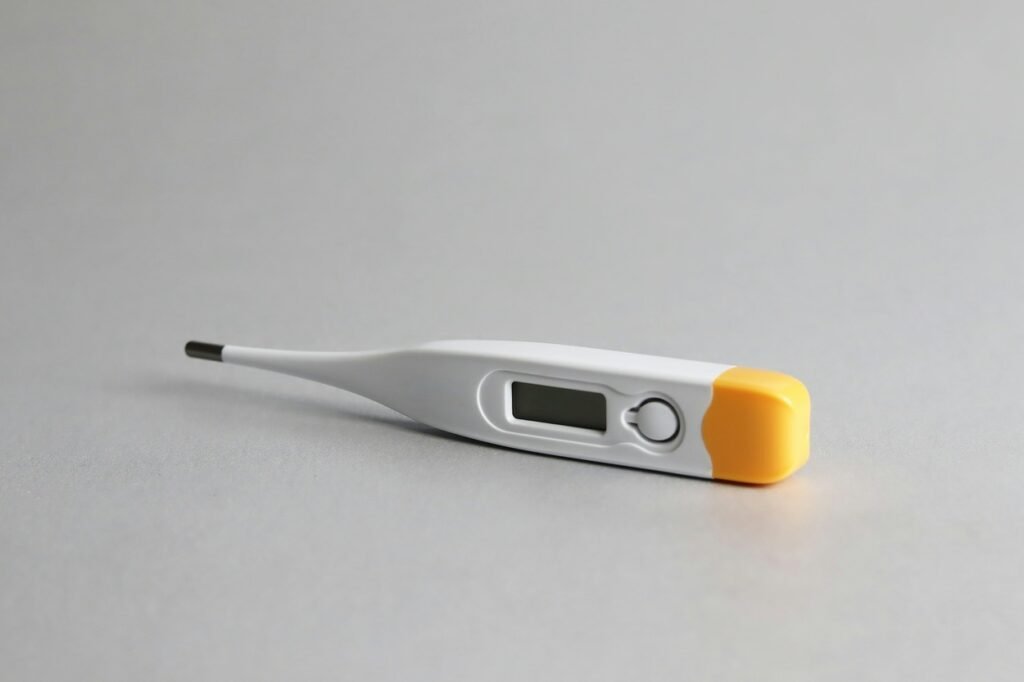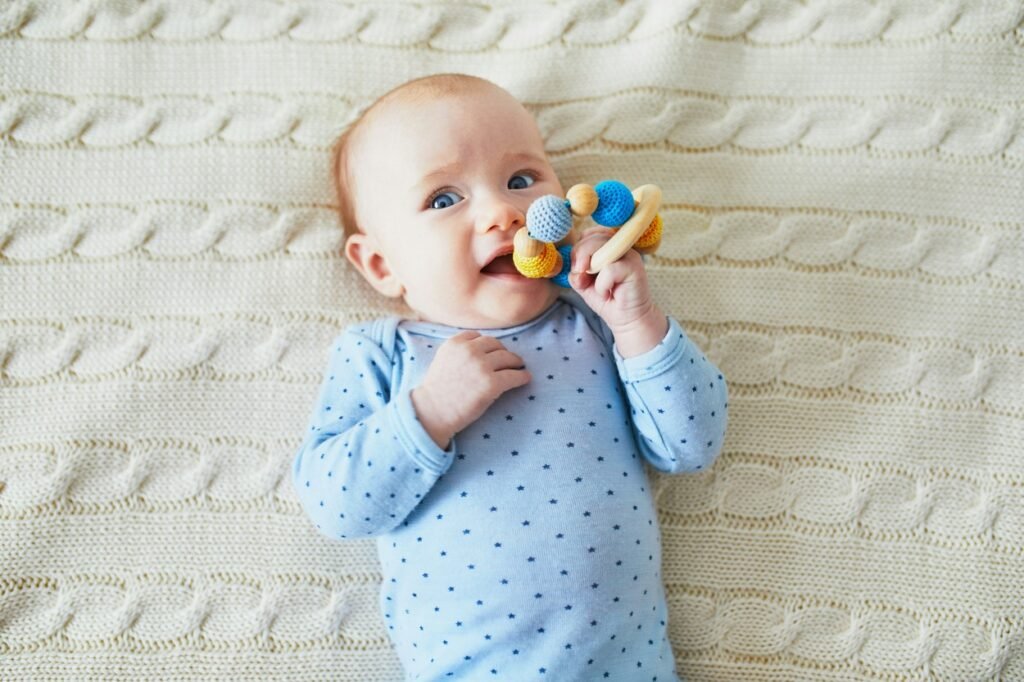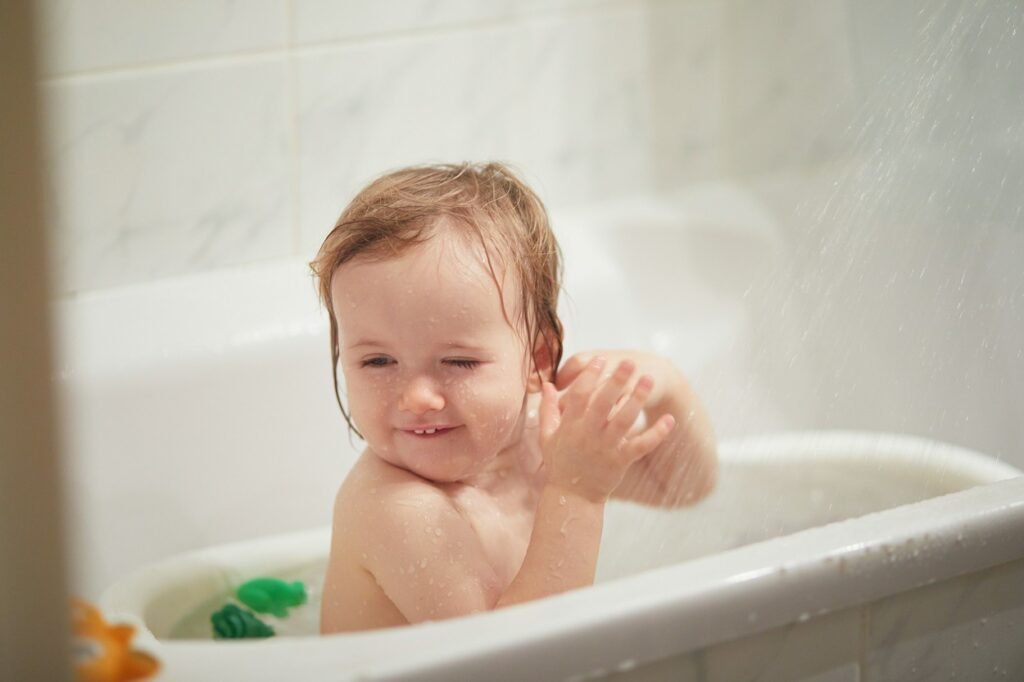Welcoming a newborn into your life is a wonderful experience that is tinged with love, joy, and a sprinkle of apprehension. Amidst the cuddles and coos, there’s one task that might seem daunting at first – bathing your tiny bundle of joy. As a parent, I’ve already been through those nerve-wracking moments twice and learned a thing or two along the way.
So, let me guide you through the tender art of bathing your newborn, easing your worries, and making it an enjoyable bonding experience for both of you.
Preparing for the Bath
Before you dip your little one into the water, it’s crucial to prepare everything like a seasoned pro. First off, gather all the essentials within arm’s reach: Grab that fluffy towel, gentle baby wash (no, it’s not for you!), a basin of warm water (think mini spa), cotton balls (for those delicate spots), and of course, a fresh diaper for the grand finale.
Babies can become chilly very quickly, so make sure the room is comfortably warm.

Timing is the Key
Instead of scheduling bath time right after a feeding (cue the milkshake mess!) or during the sleepy zone (naptime is sacred, after all), aim for a peaceful, awake moment. Let’s make bath time the highlight reel of their day! Think of it as a mini oasis amidst the chaos of baby life.
Plus, who needs lullabies when you have the soothing splash of water to prep them for a dreamy slumber?
The Right Temperature
Testing the water temperature is crucial not too hot, not too cold, but just right! Testing the water temperature is like finding the perfect balance in a yoga pose – it’s all about that sweet spot. Aim for a cozy 37 degrees Celsius (98.6 degrees Fahrenheit).
It should feel like a warm hug, not a scalding sauna or an icy plunge. And if you’re feeling fancy, whip out that bath thermometer for precise measurements.

Gentle Handling
When it comes to handling your precious bundle, think of it like holding a delicate flower – firm enough to support, yet gentle enough to not crush a petal. As you ease your little one into the water, cradle their head and neck with one hand, while your other arm supports their tiny body. It’s like a synchronized dance of love and security!
Keep a steady grip, but let your touch be as light as a feather, honoring their delicate nature with every move. After all, you’re not just bathing a baby; you’re nurturing a little miracle.
The Bathing Process
Step into the serene world of newborn bath time, where each gentle touch is a tender embrace and every drop of water whispers comfort. In this guide, we’ll navigate the delicate process of bathing your little one, ensuring safety, tranquility, and precious bonding moments along the way.
Join me as we embark on this nurturing journey, step by step, towards creating a soothing sanctuary for your newborn’s bath time ritual.
- Start with Sponge Bath- Choose sponge baths for the first few weeks until the stump of the umbilical cord falls off and the circumcision (if applicable) heals. Use a soft, damp washcloth to gently wipe your baby’s face, body, and diaper area, avoiding the cord stump or circumcision site.
- Graduate to Tub Baths- Once your baby’s umbilical cord stump has dried and fallen off, it’s time to transition to tub baths. Place your baby in a small infant tub or a clean sink, making sure they’re well-supported. To keep them warm, frequently slosh warm water over their body.
- Cleanse with Care- Use a mild baby wash or soap specifically formulated for newborns. Apply a small amount to a washcloth or your hand and gently cleanse your baby’s body, paying extra attention to folds and creases where dirt can accumulate.
- Shampoo Strategically- If your baby has hair, use a tear-free baby shampoo sparingly. Support their head and neck with one hand while gently massaging the shampoo into their scalp with the other. Rinse thoroughly with water, ensuring no soap or shampoo residue remains.
- Mind the Eyes and Ears- Be cautious around your baby’s eyes and ears. Use a damp washcloth to gently wipe their eyes from the inner corner outward, using a different corner of the cloth for each eye. Never put anything into the ear canal; instead, clean the area around the ears.
- Dry Thoroughly- Lift your baby out of the water and wrap them in a soft towel. Now, dry them off between all the little folds and creases with a gentle towel. Pay extra attention to the diaper area to prevent diaper rash.
Post-Bath Care
As the bath bubbles vanish into thin air, it’s time to embark on the post-bath pampering extravaganza! Think of it as the after-party to the splashy main event, where we’re not just cleaning up, but elevating to spa-level luxury (minus the cucumber eye masks, of course!).
So grab your towel and get ready to wrap your little one in post-bath bliss that’ll have them feeling like baby royalty in no time!
- Moisturize- Use a light baby oil or lotion after drying them off with a cloth to seal in moisture and maintain their smooth, soft skin.
- Dress Comfortably- Dress your baby in clean, comfortable clothes that are appropriate for the weather. Choose breathable, soft materials to avoid irritation or overheating.
- Dress Comfortably- Dress your baby in clean, comfortable clothes that are appropriate for the weather. Choose breathable, soft materials to avoid irritation or overheating.
- Cuddle Time- After the bath, take some time to cuddle and bond with your baby. Skin-to-skin contact is not only comforting but also promotes bonding and regulates your baby’s body temperature and breathing.

Troubleshooting Tips
Welcome to the troubleshooting zone, where we tackle bath time hiccups with wit and wisdom! Even in the bubbliest of baths, a few snags might arise – but fear not, for we’re armed with solutions sharper than a rubber duck’s quack. In this section, we’ll dive into the depths of common bath time woes and emerge victorious, ensuring your baby’s bath time remains a serene sanctuary of splashes and smiles.
So buckle up (or rather, lather up) as we navigate the waters of troubleshooting tips with a splash of humor!
- Crying Spells- Babies often cry during bath time, especially at first. Remain composed, comfort them with your voice and soft touch, and make an effort to determine and resolve the root of their anxiety, be it a fear of the unknown or the temperature of the water.
- Dry Skin– If your baby’s skin seems dry or irritated after baths, switch to a gentler baby wash or soap, and moisturize their skin more frequently. Steer clear of products that contain strong chemicals or fragrances as they can further irritate delicate skin.
- Umbilical Cord Care– Keep the umbilical cord stump clean and dry until it falls off naturally. Avoid submerging it in water during sponge baths and gently pat it dry after tub baths. Consult your pediatrician right away if you see any symptoms of infection, such as redness or discharge.
Final Thoughts
Giving your baby a bath can be intimidating at first, but with patience and practice, it will soon come naturally. Embrace each bath as an opportunity to connect with your baby, soothe their senses, and create cherished memories together.
Before you know it, you’ll be a pro at navigating the gentle art of newborn bathing, and those initial worries will fade into distant memories, replaced by the pure bliss of parenthood.
